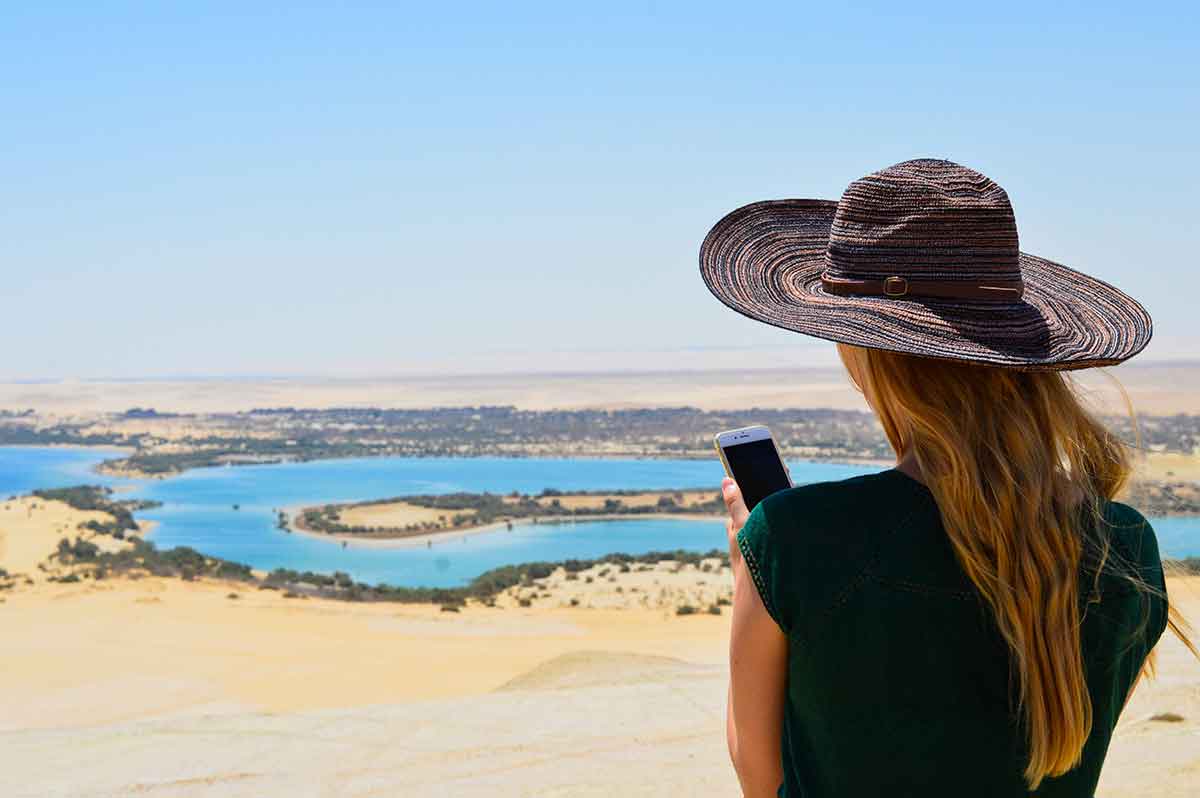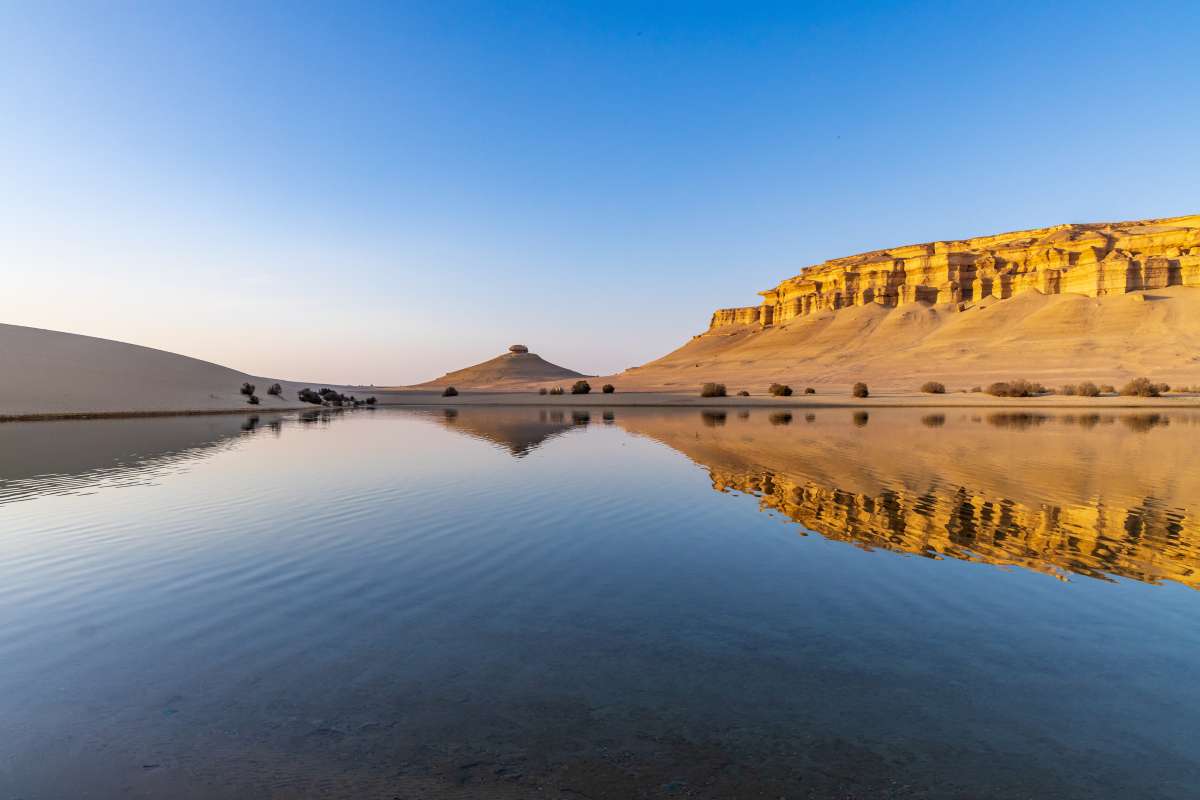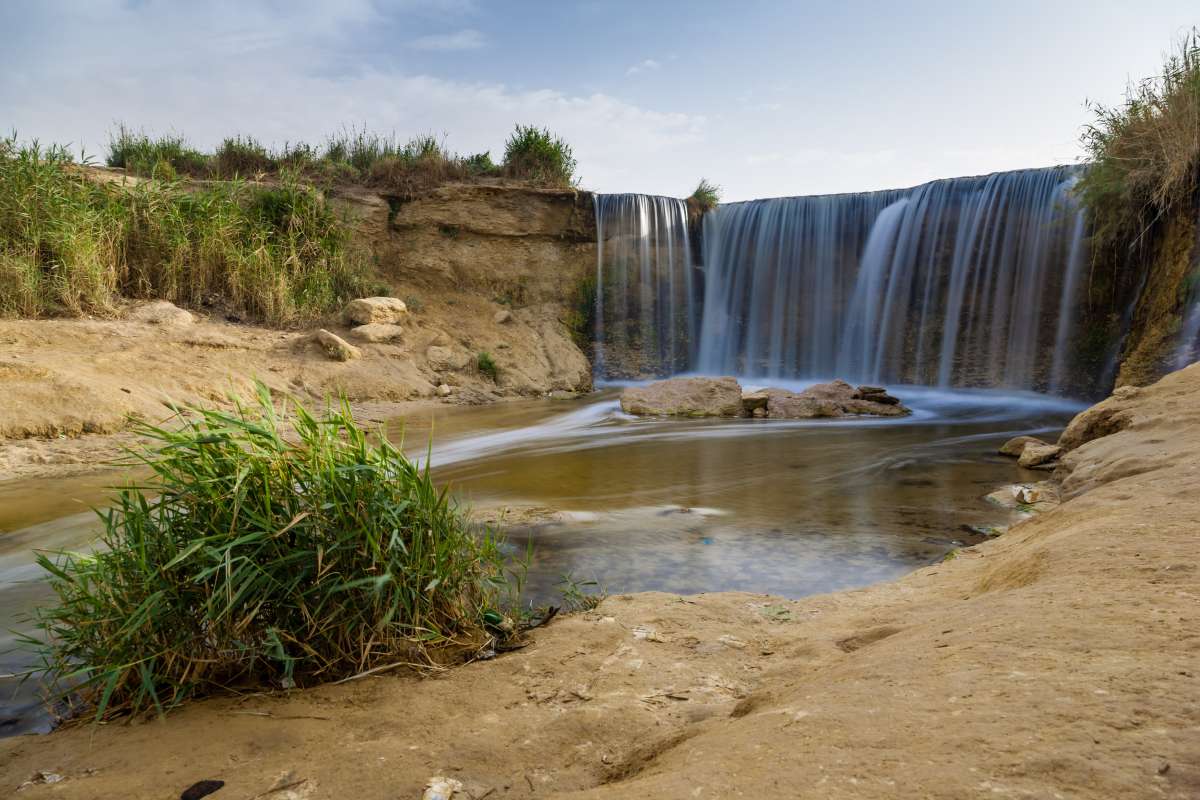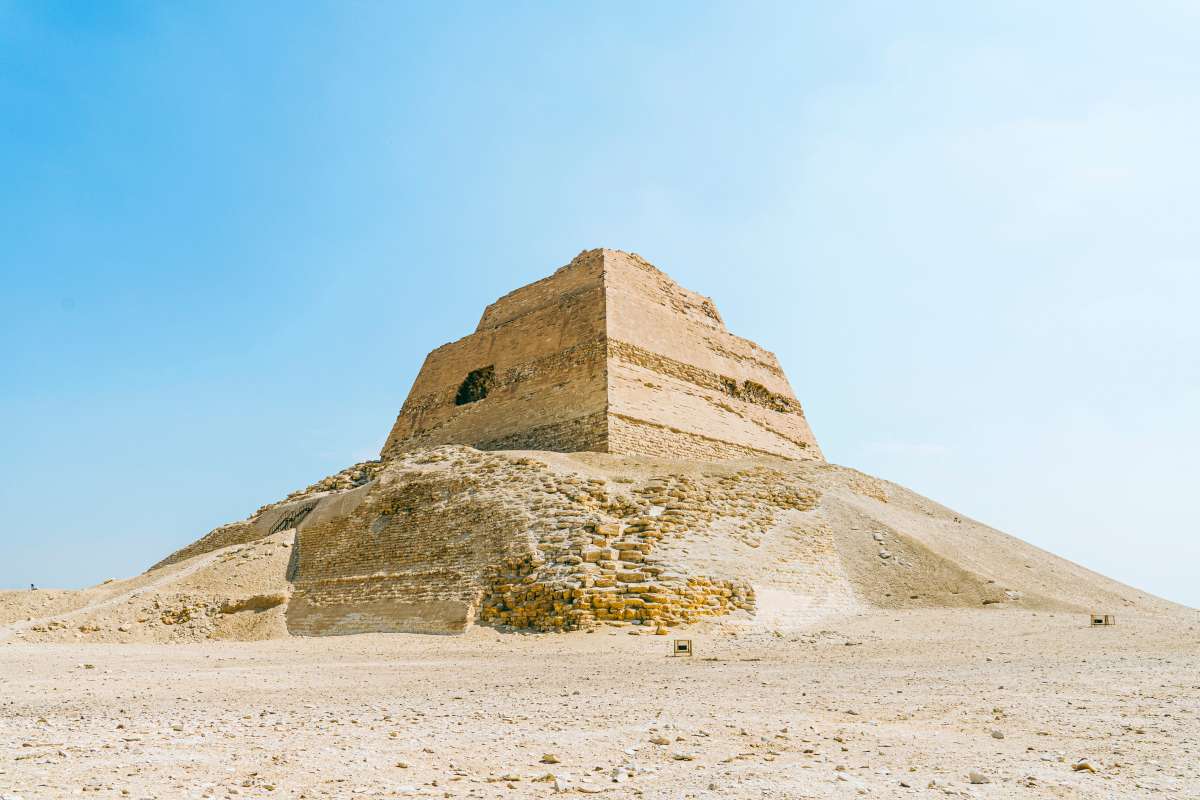When it comes to oases, El Fayum stands as the largest in Egypt. It’s not just a mere oasis; it’s an entire region with a population of over 3.5 million, intricately woven into the fabric of the country. While it may not be a part of the typical tourist routes, El Fayum offers attractions that are worth exploring if you’re considering adding this destination to your trip to Egypt. Our agency specializes in creating personalized experiences, ensuring you make the most of your visit and create unforgettable memories in El Fayum.
If you take a closer look at Egypt on Google Maps in ‘Satellite View’ mode, you’ll notice something magical. Through the innocent eyes of a child, the course of the Nile River resembles a vibrant green flower blooming against the backdrop of golden desert sand. And if you let your imagination wander, you’ll discover a small “leaf” emerging from the stem, nestled on the left side—the western bank of the river.
That enchanting leaf is none other than El Fayum, an oasis intricately connected to the Nile through the Joseph Canal (Bahr Yussef). Thousands of years ago, the river’s natural floods carved out a vast lake in this depression within the Western Desert—a natural conduit known as Lake Birket Qarun or simply Qarun (known as Lake Moeris to the Greeks). However, since the Middle Kingdom, the Egyptians ingeniously expanded and regulated the lake through sophisticated hydraulic engineering, transforming it into fertile land for cultivation. This remarkable project stands as a testament to the ancient Egyptian civilization’s profound understanding of water management.
Today, this depression is known as the El Fayum Governorate, with its capital city aptly named Medinet El Fayum. Its lush fields hold immense agricultural significance, earning it the well-deserved title of “Egypt’s Garden.” The region’s horticultural capacity plays a vital role in sustaining the entire country and supports the cultivation of plants for various industrial purposes, including textiles.
While Lake Qarun has unfortunately experienced salinization, rendering swimming impossible along its shores, El Fayum continues to captivate visitors. The capital city may not boast grand monuments or architectural marvels, yet it has become a favored destination for both locals from Cairo and an increasing number of international travelers seeking a tranquil holiday retreat. Discover the reasons behind its allure as we delve into the remarkable attractions and activities that await you in El Fayum.

The tourist attractions in El Fayum are of natural and historical-cultural character. Here are some suggestions if you plan to travel to this region near the Nile Valley.

While swimming may not be an option in Lake Qarun, there are countless ways to appreciate the splendor of this vast body of water. One such way is to take a leisurely stroll aboard a small rowboat, reminiscent of the leisurely pastime enjoyed by King Farouk, Egypt’s last monarch, who frequented the former Auberge du Lac hotel. This luxurious establishment also played host to representatives of the allied powers, shaping the geopolitical landscape of the Middle East in the aftermath of World War II.
For birdwatching enthusiasts, Lake Qarun presents a veritable paradise. The abundance and diversity of bird species that congregate here, particularly during the winter months when migratory birds seek respite from the chill of the Northern Hemisphere, make it a highly recommended spot for this captivating hobby. The avian diversity has been celebrated since ancient times, as evidenced by the famed “Meidum Geese” found in the mastaba of Nefermaat in Meidum, now on display at the Egyptian Museum in Cairo.
While the vicinity of Lake Qarun may not boast as many archaeological sites and ancient monuments as other areas, enthusiasts of archaeological tourism can still indulge their passion with several captivating visits. One notable destination is Qasr Qarun, a Ptolemaic-era temple dedicated to Sobek, the crocodile god held in great reverence across Egypt’s oases. This temple, restored several decades ago, offers access to its underground chambers and panoramic rooftop views of the surrounding landscape.
Another archaeological site from the same era is the Karanis site (also known as Kom Aushim), albeit in a slightly less preserved state. Situated near the eastern sector of the lake, this settlement once flourished with several temples and Roman baths. Excavations have unearthed fascinating artifacts such as ceramics, terracotta figurines, and glass objects, which can now be admired at the Kom Aushim Museum in the city of El Fayum.

Situated approximately 60 km southwest of El Fayum, Wadi El Rayyan stands as another significant water body within the region. It is composed of two interconnected lakes that have been shaped by human intervention, with a cultivated strip of land serving as a conduit for irrigation water. Remarkably, this human-altered landscape has not hindered the environmental preservation efforts in the area. Here, you will discover a captivating natural wonder: one of Egypt’s grandest waterfalls, a sight to behold.
Located just 10 km east of El Fayum, Hawara once stood as a prominent city in Ancient Egypt. It held great religious significance as the center of worship for the crocodile deity Sobek, particularly during the Middle Kingdom era. One of the remarkable legacies of this ancient city is its necropolis, predominantly established by Amenemhat III of the 12th Dynasty. This pharaoh, who played a pivotal role in developing the region through the Joseph Canal project, chose this site for his funerary complex. Today, you can still catch a glimpse of his pyramid, albeit transformed into a weathered stone mound that has lost its original form. However, the most renowned discoveries within this necropolis are the coffins adorned with the iconic “Fayum portraits,” which we will delve into further below.

Nestled just 40 km away from the city of El Fayum, although administratively part of the Beni Suef Governorate, lies the lesser-known Meidum Pyramid. Constructed during the reign of Sneferu in the Old Kingdom’s 4th Dynasty, around 2600 BC, this pyramid boasts a unique and intriguing feature—an appearance resembling a tower. Its construction, primarily made of limestone, suffered a mysterious collapse at some point, exposing only its central core.
What sets the Meidum Pyramid apart is its distinction as one of the earliest pyramids adorned with a meticulously smooth outer casing, which can still be observed in certain sections of its base. The site also includes additional funerary structures such as mastabas for officials, a funerary temple, and a grand processional causeway. Visitors have the opportunity to explore its interior, and while it may lack the elaborate decorations found in other royal burial sites, the sheer presence and scale of this ancient monument leave a lasting impression on all who venture inside.
One cannot overlook the mesmerizing artistic masterpieces known as the “El Fayum portraits” when delving into the rich tapestry of history. Although these portraits may not be accessible during your visit to the El Fayum oasis, you have the opportunity to witness them in close proximity at the renowned Egyptian Museum in Cairo.
These captivating portraits, crafted with astonishing realism between the 1st and 4th centuries, were discovered in the necropolis of Hawara. Created during the subjects’ lifetimes, they were intricately affixed to the coffins of the departed. This remarkable practice has unveiled the extraordinary technical prowess achieved by artists of that era and has provided valuable insights into the fashion trends of the time, encompassing intricate hairstyles, exquisite jewelry, and fashionable attire.
Regrettably, the majority of these remarkable El Fayum portraits departed their homeland after their unearthing in the late 19th century. They now adorn the collections of esteemed museums across the globe, predominantly in the United States and Europe. Nonetheless, within the Egyptian Museum in Cairo, you can marvel at preserved examples that remain harmoniously united with their coffins, forming an inseparable testament to a bygone era.
One of the key advantages for travelers planning to explore El Fayum is its close proximity to Cairo, a mere 100 km south of the bustling capital. As a result, the airports catering to this region are the same as those serving Cairo and its environs: the International Airport and Sphinx Airport in Giza.
However, reaching El Fayum by boat or train is not viable since the Joseph Canal is not designed for cruises, and the Egyptian railway network does not extend to this area. While buses are a transportation option utilized by local Egyptians, it’s worth noting that major tourist companies typically do not include El Fayum in their regular routes.
To travel to the enchanting oasis of El Fayum, the most favorable option is to arrange private transportation, such as taxis or medium-sized vehicles with a knowledgeable driver. This allows for convenient travel from Cairo, Giza, or other nearby tourist destinations. Here’s a helpful list of distances and estimated travel times for your reference:
Considering the significance of reliable road transportation for exploring El Fayum, our agency is here to be your trusted companion throughout your journey. With Egipto Exclusivo, you can experience the wonders of El Fayum in utmost comfort and safety. Allow us to make your trip unforgettable!


Fill out the form below to receive a free, no-obligation, tailor-made quote from an agency specialized in Egypt.
Travel agency and DMC specializing in private and tailor-made trips to Egypt.
Mandala Tours, S.L, NIF: B51037471
License: C.I.AN-187782-3